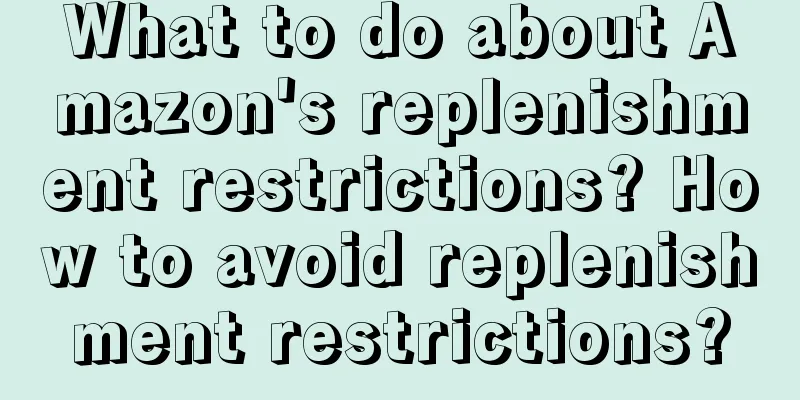What to do about Amazon's replenishment restrictions? How to avoid replenishment restrictions?

|
Merchants who open stores on Amazon sometimes encounter storage restrictions. If you encounter Amazon's replenishment restrictions when the order volume may surge during the peak season, it will be a headache. So, what should you do about Amazon's replenishment restrictions? The main reason for Amazon sellers to be restricted from restocking is that the platform does not meet the inventory performance index score requirements. For example, the current assessment standard is that sellers with scores below 450 will have storage restrictions. In addition, factors such as too small restocking quantity and transportation methods may also lead to your restocking restrictions. If you encounter replenishment restrictions, you can try to break through them from the following points: 1. For the same ASIN, create several follow-up links in the background; 2. Each follow-up link must reach the maximum delivery limit; 3. Build goods and plans for each link separately; 4. It is best to open multiple shipping web pages at the same time and submit them simultaneously. However, please note that you should not create too many follow-up sales for the same listing in the same store, as this may easily lead to the risk of abuse of variant warnings. How to avoid restocking restrictions? 1. Don’t transport too much goods. 2. It is best to use express delivery, such as UPS, DHL, etc. 3. Delete redundant shipment plans Allowed replenishment shipment quantity = Maximum allowed inventory level - Inventory limit usage However, it does not specify how the "maximum inventory level allowed" and "inventory limit usage" are calculated. In fact, the maximum inventory level allowed is generally = average daily sales quantity * 90 days Amazon generally has enough storage space for most products to last for more than 3 months of sales. The inventory limit is usage = inventory quantity + incoming shipments (including those in transit) + inventory waiting to be removed + inventory reserved for orders to be delivered. So, when you find that the quantity available for sale is low and the quantity allowed for replenishment is too low. You need to consider this question first: Is the number of incoming shipments (including those in transit) too large, or is the transportation too slow? The above is an introduction to the solution to Amazon's replenishment restrictions. There are many reasons for Amazon's replenishment restrictions, such as too small replenishment quantity, transportation method, and assessment standard score below 450 points. |
<<: Where can I check Amazon's IPI? How can I improve it?
>>: How often does Amazon update its warehouse capacity? How is Amazon's storage fee calculated?
Recommend
What is eBay's current official logistics? Which model should it mainly adopt?
As the world's leading e-commerce platform, eB...
Is Shopee's reconciliation reliable? What is the difference between upcoming and already allocated funds?
Shopee is a cross-border e-commerce platform. I be...
Hot on the Internet, can the "business secrets" of Zibo barbecue be replicated?
Zibo barbecue has become a "phenomenon"....
Can I shop on Amazon in China? How long does it take for the goods to arrive?
Amazon has a very wide market coverage. Merchants ...
How important is the role of reviews in online shopping?
Reading reviews when shopping online is an importa...
Does Shopify require rent? What are the Shopify transaction fees?
Cross-border e-commerce on Shopify adopts the mode...
Little Red Book, Going Out to Sea Overnight
As TikTok faces the storm of being removed from th...
What impact does the Amazon Advertising Archive have and why?
When opening a store and placing advertisements on...
The end of product marketing is cilantro?
Do you like cilantro? Regardless of the answer, wh...
TikTok is no longer running wild
Before this, the only apps in the world with more ...
What is Wanlihui? Is Wanlihui safe?
In this context, cross-border payments are becomin...
Can individual merchants join shein? Are the entry requirements strict?
Shein is an international fashion e-commerce platf...
The post-00s official account operator is using cat memes to bravely enter the workplace
"Cat meme" has become the secret to the ...
How to avoid losses in Pinduoduo
On Pinduoduo, a fiercely competitive e-commerce pl...
Do Amazon sellers need to pay taxes in the country? What taxes do they need to pay?
Many merchants like to open stores on Amazon. Afte...









